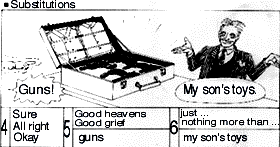Step 5: When students have
been talking to each other for ten minutes or so, ask a pair
of students who have been doing particularly well to come to
the front of the class and "perform." Repeat this activity
with three or four different pairs of students. The rules for
grading these conversations are quite simple: students have to
speak for as long as they can (without using any Japanese); also,
the closer the students' dialogues resemble the original text
the fewer the points they receive. This is one way to emphasize
the importance of personal expression as well as to reward creativity.
If you have a good class and your students are really confident,
you could select a pair at random to make the interaction look
more like a natural conversation instead of a "replay"
of the original dialogue. Also, from time to time, you might
like to ask questions related to the content of the dialogues
to the class in general. By doing so, students who are not participating
in the dialogue in front of the entire class are still involved
and need to be alert because of the possibility of having to
answer a question. Students who perform in front of the class
as well as students who answer questions related to the content
of the dialogues should be graded for their effort. You might
also want to record the students' performances on audio or video
so as to give them a more "objective" view of their
interactions. If their level and participation is minimal, however,
it could have the opposite effect (in which case, don't tape
or film them). |


